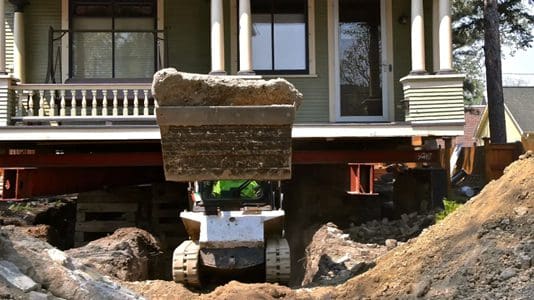Whether you’re a new homeowner or have lived in your home for years, if the foundation needs repair or replacement, it should be a top priority. If you’re looking into fixing your home’s foundation, this blog post is here to help! Here, we cover how to put a new foundation under an existing house and reveal the tell-tale signs that your foundation may need replacing.
Read on to explore the steps involved when hiring foundation repair services and factors that can affect the foundation repair process, cost, and timeline.
Why Is It Important to Have a Strong Foundation?
The foundation of a building is a critical component of its structural integrity. It supports the weight of the building and transfers it to the ground below.
Typically made from concrete, foundation strength and stability are crucial to the safety and longevity of the building. Over time, however, a foundation may become damaged or compromised; in some cases, it may require a full replacement. An entire roof replacement is complex and costly but necessary to ensure the safety and stability of the building.
Signs Your Foundation Needs Replacing
There are several signs to look for that may indicate your building’s foundation needs replacement. The most obvious sign is visible cracks in the foundation, especially if they are wider than 5 millimetres or in multiple locations.
Another sign is uneven floors or walls caused by the foundation settling or shifting. Doors and windows that stick or are difficult to open and close may also indicate foundation damage. Additionally, water damage or mould on the walls or floors may indicate a problem, as water can seep through cracks and compromise the structural integrity of the building.
You should consult a professional if you’re concerned about your home’s structural integrity.
How to Replace Your Home’s Foundation
Hire a Professional
As with any construction work, the help of experienced professionals will make or break your project. Foundation specialists will assess the state of your home’s foundation and determine the ideal course of action, which in many cases, will be a full replacement.
Prepare the Site
If replacement is necessary, the first step is obtaining relevant permits and approval from local authorities. Once the paperwork is complete, it’s time to prepare the site. Trees, shrubs, and any surrounding structures that are in the way will need to be removed and cleared from the site.
All existing utilities surrounding the foundation, including gas and water lines, for example, should be identified. Finally, safety measures like fencing and signage are important to indicate the construction site.
When the site is ready, contractors will support the house with jacks or other temporary structures and excavate the surrounding area. All remaining debris is cleared from the site, and the soil is graded to ensure proper drainage.
Pour Your New Foundation
The construction of a new foundation is a critical stage of the process. It involves pouring the footing, building the foundation walls’ forms, installing reinforcing steel and any necessary plumbing or electrical conduits.
With these steps complete, your contractor will begin pouring the concrete for your new foundation. The footing is the foundation’s base and is the first part poured. It provides a solid foundation for the walls and ensures even distribution of your home’s weight.
Next, foundation specialists construct forms for the walls and install reinforcing steel to provide additional strength and stability. Finally, the concrete is poured into the forms, filling the space between the forms and the reinforcing steel. This process creates a solid foundation that can support the weight of the house for years to come.
Once complete, your specialists will make any final repairs and modifications to ensure the strongest foundation for your home.
Other Factors to Consider
Cost and Timeline of a Foundation Replacement
The cost and timeline of a foundation replacement project vary depending on several factors, including:
- The size and complexity of the structure. Larger and more complex structures typically require more extensive work and a longer timeline.
- Foundation type. Different foundations require different approaches and materials for replacement.
- Site accessibility. Difficult-to-reach or remote locations may require additional resources and time to complete the work.
- Soil conditions. Unstable soil or extreme weather conditions can increase the complexity and cost of the work.
Unexpected issues can also arise during the project, which may increase the cost and timeline of the work. Discuss potential issues with your specialist beforehand to avoid any surprises and include them in the estimate.
A Temporary Living Arrangement
Aside from the construction, you can organise a temporary living situation. The process of foundation replacement creates noise, vibration, and dust, resulting in a less-than-convenient living environment. Along with the potential safety risks, it’s worth considering temporary accommodation if these factors are likely to impact your day-to-day life.
Obtain Multiple Quotes for Your Foundation Replacement
Foundation replacement is a complex and costly process requiring careful planning and budgeting. When hiring a foundation repair contractor, obtaining multiple quotes from different companies is a good idea to ensure you get a fair and accurate estimate of the project’s cost.
Get Your Foundation Sorted with Grace Foundation Solutions
Whether you require a full replacement, concrete repair services, or a standard inspection, we can help. Contact the team at Grace Foundation today to learn more about our services or get a quote on your foundation replacement.

